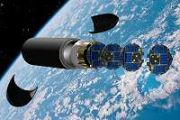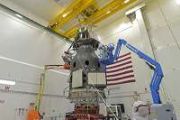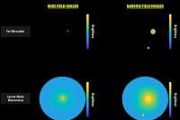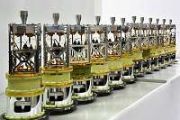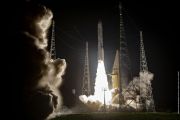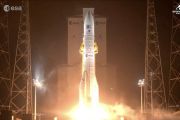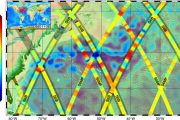
Copernical Team
A few steps closer to Europa: Spacecraft hardware makes headway

Take a closer look at the complex choreography involved in building NASA's Europa Clipper as the mission to explore Jupiter's moon Europa approaches its 2024 launch date.
The hardware that makes up NASA's Europa Clipper spacecraft is rapidly taking shape, as engineering components and instruments are prepared for delivery to the main clean room at the agency's Jet Propulsion Laboratory in Southern California. In workshops and labs across the country and in Europe, teams are crafting the complex pieces that make up the whole as mission leaders direct the elaborate choreography of building a flagship mission.
The massive 10-foot-tall (3-meter-tall) propulsion module recently moved from NASA's Goddard Space Flight Center in Greenbelt, Maryland, to the Johns Hopkins Applied Physics Laboratory (APL) in Laurel, Maryland, where engineers will install electronics, radios, antennas, and cabling. The spacecraft's thick aluminum vault, which will protect Europa Clipper's electronics from Jupiter's intense radiation, is nearing completion at JPL. The building and testing of the science instruments at universities and partner institutions across the country continue as well.
NASA's Juno celebrates 10 years with new infrared view of moon Ganymede

The spacecraft used its infrared instrument during recent flybys of Jupiter's mammoth moon to create this latest map, which comes out a decade after Juno's launch.
The science team for NASA's Juno spacecraft has produced a new infrared map of the mammoth Jovian moon Ganymede, combining data from three flybys, including its latest approach on July 20. These observations by the spacecraft's Jovian Infrared Auroral Mapper (JIRAM) instrument, which "sees" in infrared light not visible to the human eye, provide new information on Ganymede's icy shell and the composition of the ocean of liquid water beneath.
JIRAM was designed to capture the infrared light emerging from deep inside Jupiter, probing the weather layer down to 30 to 45 miles (50 to 70 kilometers) below Jupiter's cloud tops.
Week in images: 02 - 06 August 2021

Week in images: 02 - 06 August 2021
Discover our week through the lens
Virgin Galactic restarts space-trip sales at $450,000 and up

Lunar samples solve mystery of the moon's supposed magnetic shield

In 2024, a new age of space exploration will begin when NASA sends astronauts to the moon as part of their Artemis mission, a follow-up to the Apollo missions of the 1960s and 1970s.
Some of the biggest questions that scientists hope to explore include determining what resources are found in the moon's soil and how those resources might be used to sustain life.
In a paper published in the journal Science Advances, researchers at the University of Rochester, leading a team of colleagues at seven other institutions, report their findings on a major factor that influences the types of resources that may be found on the moon: whether or not the moon has had a long-lived magnetic shield at any point in its 4.53 billion-year history.
What lies beneath the far side of the moon?

A new technique for processing lunar radar data has allowed scientists to see what lies beneath the surface of the moon in the clearest ever detail.
In a study led by the University of Aberdeen, a team of researchers discovered multiple layers of soil that lie directly beneath an area on the far side of the moon's surface, overturning an existing theory of a single deep layer in the same area.
The area studied was the landing site of the Chang'E-4 spacecraft mission—the first to the far side of the moon.
Analysis of radar data captured by the mission's rover, Yutu-2, had suggested the existence of a single soil layer in the moon's regolith (subsurface). However, the data did not indicate the existence of different layers of soil, which were transparent to electromagnetic waves due to the smooth boundaries between them.
By developing a new method of processing the data captured by Yutu-2, which uses the shape of radar signatures of buried rocks and boulders to infer the properties of surrounding lunar soil and detect previously unseen layers with smooth boundaries, scientists were able to detect four distinct layers of soil, stacked to a depth of 12 meters.
Earth's Magnetosphere: Protecting Our Planet from Harmful Space Energy
 Among the four rocky planets in our solar system, you could say that Earth's "magnetic" personality is the envy of her interplanetary neighbors.
Unlike Mercury, Venus, and Mars, Earth is surrounded by an immense magnetic field called the magnetosphere. Generated by powerful, dynamic forces at the center of our world, our magnetosphere shields us from erosion of our atmosphere by the solar
Among the four rocky planets in our solar system, you could say that Earth's "magnetic" personality is the envy of her interplanetary neighbors.
Unlike Mercury, Venus, and Mars, Earth is surrounded by an immense magnetic field called the magnetosphere. Generated by powerful, dynamic forces at the center of our world, our magnetosphere shields us from erosion of our atmosphere by the solar NASA's Oceans Melting Greenland Mission Leaves for Its Last Field Trip
 This week, NASA's airborne Oceans Melting Greenland (OMG) mission begins its final survey of glaciers that flow from Greenland into the ocean. OMG is completing a six-year mission that is helping to answer how fast sea level is going to rise in the next five, 10, or 50 years.
Greenland's melting glaciers currently contribute more fresh water to sea level rise than any other source does. Th
This week, NASA's airborne Oceans Melting Greenland (OMG) mission begins its final survey of glaciers that flow from Greenland into the ocean. OMG is completing a six-year mission that is helping to answer how fast sea level is going to rise in the next five, 10, or 50 years.
Greenland's melting glaciers currently contribute more fresh water to sea level rise than any other source does. Th 
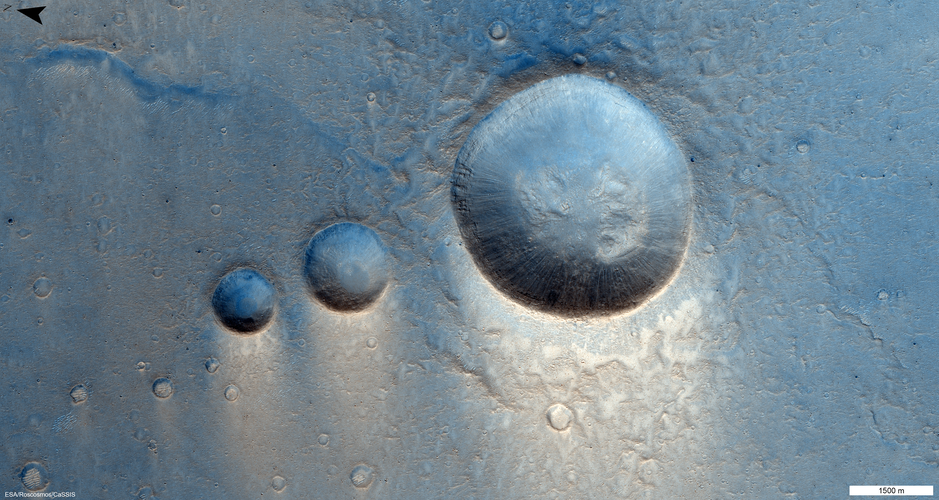 Image:
Crater trio
Image:
Crater trio 


